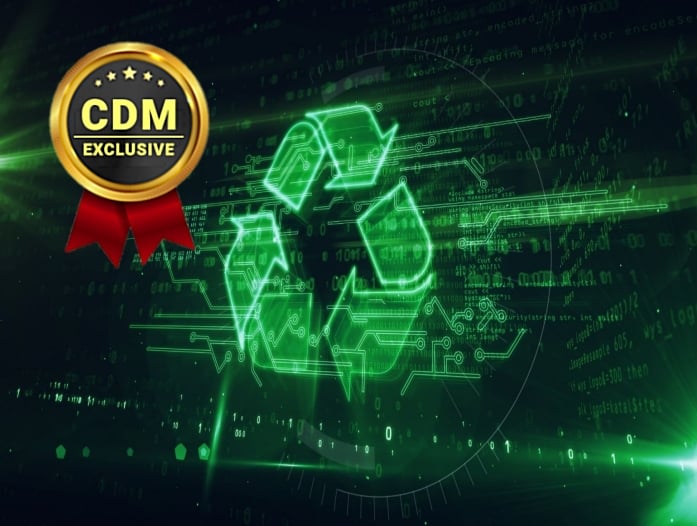An Outline of the Importance of Proper E-Waste Disposal for Enterprise Best Practices in terms of both CSR and Cybersecurity
By Milica Vojnic, Senior Digital Marketing Executive, Wisetek
E-waste is a growing concern. In 2021 alone, it’s estimated that more than 63 million tons of electronic waste was generated globally. When improperly disposed of, e-waste can release toxic chemicals into the atmosphere. Furthermore, irresponsible e-waste disposal is putting significant strain on the future availability of non-renewable precious metals. Every year, around $10 billion worth of platinum, gold, and palladium end up in a landfill.
However, responsible e-waste disposal isn’t just about sustainability. For organizations worried about cybersecurity, data erasure is just as important as the physical destruction or recycling of hardware and electronic devices.
Enterprise E-Waste Explained
E-waste can include anything from everyday appliances to the plugs and cords that power them. In the United States, the average person produces around 46 pounds of e-waste every year. For businesses, e-waste statistics are far more staggering.
While the average consumer may replace one or two electronic devices annually, a typical business will actively replace every piece of hardware within an organization once every few years. This includes laptops, desktops, servers, printers, and much more. Although businesses than ever before are committing to sustainable practices when disposing of e-waste, only a fraction of electronic waste is recycled.
E-waste is on the rise. By 2030, annual e-waste production is set to hit 82 million tons globally. Organizations need to take charge of responsible e-waste disposal to offset the environmental impact. However, it’s not just about being sustainable. Proper disposal of electronic waste also makes sense for businesses looking to mitigate cybersecurity risks.
E-Waste and Cybersecurity Risks
Even when properly maintained, IT equipment and electronic assets naturally reach the end of their operational life. To maintain business-critical processes, these assets need to be replaced. Chances are, you’ll invest considerable time and effort into protecting these new devices against cybersecurity threats. However, discarded devices will also need to be safeguarded to ensure valuable data isn’t accessed by malicious third parties.
What Data Can Hackers Access?
If e-waste isn’t properly disposed of, you’re making life easy for hackers. If you’ve taken no steps to destroy data, even criminals with minimal hacking expertise can access information. Naturally, this poses a significant cybersecurity risk to any organization.
It’s easy to overlook the extent of sensitive information contained on hardware. Many companies prioritize data erasure with things like flash drives and desktop computers, but seemingly innocuous devices like fax machines can also provide a treasure trove of information for hackers.
Even if you have robust e-waste protocols in place, there’s no guarantee every piece of data has been destroyed permanently. Many companies assign data erasure tasks to internal teams. This is certainly cost-effective, but it’s worth bearing in mind that a significant proportion of wiped hard drives can still contain retrievable data. Worryingly, a recent study suggests more than 10% of wiped drives may contain recoverable information.
Data Breach Statistics
If a hacker gets their hands on a device that hasn’t been successfully wiped of sensitive information, you leave yourself vulnerable to data branches. According to the 2021 Data Breach Report compiled by the Identity Theft Resource Center, there were 1,862 data branches in 2021. This represents a significant increase from previous years. More concerning is that cybercriminals were shifting focus to high-value enterprise targets, rather than concentrating their efforts on individual victims.
Around a third of businesses experience some form of data breach each year. Although the vast majority of breaches are the result of email-based phishing scams, an increasing number are occurring because of e-waste that’s been improperly disposed of. The financial implications of a data breach can be devastating to organizations. In 2021, average data breach costs hit $4.24 million. This is a marked increase from previous years and represents the highest average since records began.
It’s not just the financial cost of data breaches that businesses need to worry about. Falling foul of a data breach is a clear indication you’re not taking enterprise cybersecurity, which can be catastrophic for brand identity and reputation. Most businesses go above and beyond when investing in securing their hardware assets and internal networks. Furthermore, most organizations educate employees on anti-phishing practices during the onboarding process. However, these efforts are futile if you’re not working to mitigate cybersecurity risks posed by substandard e-waste disposal.
E-Waste Disposal Best Practices
When disposing of e-waste, committing to sustainability and mitigating cybersecurity risks go hand in hand. The foundations of secure e-waste disposal ultimately hinge on clearly defined asset lifecycle management. With this in place, there’s no chance of end-of-life assets slipping through the net before thorough data destruction has been performed.
When it comes to erasing data, simply wiping a hard drive isn’t enough. To ensure that sensitive information can never be retrieved, certain components will need to be physically destroyed. Even then, there’s a slight chance that recoverable information may remain. This is why employing the services of an IT Asset Disposition (ITAD) partner is recommended.
IT Asset Disposition Explained
IT Asset Disposition companies are becoming increasingly popular with companies eager to protect themselves from data branches and reduce the environmental impact generated from e-waste. As of 2021, the ITAD market was worth $5.8 billion in the United States alone. By 2026, the US market is expected to be worth more than $7.2 billion.
ITAD companies are the obvious choice for businesses without the resources to take charge of data destruction and device sanitization themselves. However, these companies provide far more than peace of mind. These providers are fully versed in best practices and ensure your business adheres to the latest data protection regulation legislation. If your enterprise is a global one, ITAD makes staying compliant simple in every territory you have business interests in.
If you’re considering utilizing ITAD, look for providers that provide full oversight of data destruction procedures. Every step of the process should be itemized, while certification of data erasure should also be provided. ITAD providers should also be able to provide full evidence of certification in any area they operate in.
The other major benefit of ITAD partners is that they will usually ensure the hardware itself is responsibly recycled. Once data has been destroyed, your end-of-life assets will be delivered to compliant recycling facilities. This means precious metal resources can be reclaimed for future use, while toxic elements like mercury, lithium, and lead are prevented from polluting the environment.
Taking Charge of E-Waste Disposal
Rethinking your approach to e-waste disposal is essential if you want to maintain green credentials and ensure your enterprise is protected against cybersecurity threats. E-waste looks set to increase considerably over the next decade. As more devices are retired from service, the chance of you falling foul of cybersecurity risks also increases.
Too many companies focus solely on protecting existing infrastructure and in-use assets. While this is crucial, the disposal of end-of-life assets requires special attention. It all starts with asset lifecycle management. Once hardware reaches is ready to be retired, you need to ensure that rigorous data destruction procedures are adhered to. It’s tempting to rely on in-house teams to handle data destruction, but investing in IT Asset Disposition is, without doubt, the best approach.
Conclusion
With data breaches on the rise and more e-waste being produced than ever before, the ITAD market is thriving. Certified ITAD companies will provide you with a guarantee that data has been successfully destroyed, while also ensuring your remain GDPR compliant in every territory you’re operating in. By using an ITAD provider, you not only mitigate cybersecurity risks, but you’re also ensuring that hardware is disposed of responsibly, causing minimal impact to the environment.
About the Author
 Milica Vojnic is a Senior Digital Marketing Executive at Wisetek, who are global leaders in manufacturing, data sanitization, reuse, and IT asset disposition. Wisetek’s goal is to provide world-class IT services that are world-class in terms of sustainability, security, and compliance. Vojnic specializes in advising businesses in avoiding Data Breaches through effective Data Destruction Services, include proper e-waste disposal. Vojnic is also the author of articles outlining these topics for a variety of online publications. Milica can be reached online at https://ie.linkedin.com/in/milicavojnic and at our company website https://wisetek.net/
Milica Vojnic is a Senior Digital Marketing Executive at Wisetek, who are global leaders in manufacturing, data sanitization, reuse, and IT asset disposition. Wisetek’s goal is to provide world-class IT services that are world-class in terms of sustainability, security, and compliance. Vojnic specializes in advising businesses in avoiding Data Breaches through effective Data Destruction Services, include proper e-waste disposal. Vojnic is also the author of articles outlining these topics for a variety of online publications. Milica can be reached online at https://ie.linkedin.com/in/milicavojnic and at our company website https://wisetek.net/


